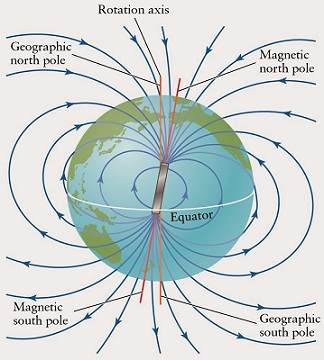Several considerable progresses have been made in unveiling the fact related to the orientation and migration of various animals including terrestrial and aquatic. Currently, a recent theory has been proposed highlighting the migration of salmon and magnetic fields that are the guiding tool for them.

Salmon and their migration habit:
Salmon is the common name given to the fishes that belongs to the family named as Salmonidae. Fishes belonging to this family usually migrates from ocean, reaches to the upper river where they used to spawn on the gravel beds. These fishes live in the river (containing salt water) in their early life stages and then migrate to sea (containing fresh water) where they spend their adult’s life. This migration is termed as “Salmon run”.
Salmon has several species namely Atlantic salmon, Chinook salmon, chum salmon and several others. This particular theory has been suggested certainly for Chinook salmon. During this Salmon run, salmon faces various obstacles as many predators such as bears, eagles, fisherman waits for the salmon run. They generally congregate by streams and rivers where they spawn. California sea lions, steller sea lions and harbour lions pose a great threat, even in the river ecosystem.
Spawning period of Salmon:
Spawning is the major reason why these salmons migrate to the river. Salmon generally spawn in the shallow place like rocks and gravel. The female make a nest and there she lays her eggs. Male fertilizes them usually in smaller rivers and streams further up the river from tidal lower parts. Mostly, salmon die after spawning, as they become weak by travelling. The spawning area of the salmon is known as “Redd”. The spawning period vary as per the species of salmon; Chinook (King) Salmon spawn between months of September and October. Coho that is, Silver Salmon spawn between the months of October-November and Atlantic salmon spawn between the months of November-December.
Concept of magnetic field guiding salmon:
Navigation of the animals is studied by following the three basic approaches:
a) First phase incorporates laboratory trial in order to study the behavioural patterns of animals.
b) Second phase, includes experimenting practically conducted in the ocean.
c) And finally, to imminent the navigational methods the Migratory routes can also be analyzed.

It was a theory that fishes respond to the magnetic field of the earth. These magnetic fields were considered as a source for lots of migratory birds, turtles etc. Recent experiments conducted by scientists confirmed that this correlation between the migration prototypes of ocean salmon and the magnetic field of earth. These series of experiments were conducted at Oregon Hatchery Research Center in the Alsea River basin. The experiment has confronted many facts like fishes responses to the magnetic field was not learned or based on the experience, but it was inherited. This conveys a statement that these fishes were programmed in advance for what to do before they arrive at the ocean.
To test this hypothesis, a pre-planned procedure has been followed by the scientists:
a) The researchers manufactured a large platform having the copper wires running horizontally and vertically around the perimeter.
b) By flowing, the electrical current along the wires, scientists may create the magnetic field and control both the intensity and the inclination angle of field.
c) Then they keep 2’’ juvenile salmon known as ‘parr’ within the 5-gallon buckets and, after acclimation period, monitored and photographed direction where they were swimming.
d) A range of Chinook salmon fishes encompass with a magnetic field features of the northern limits of the oceanic range to swim in the direction of south whereas fish encountering the far southern field tended to swim in the direction of north. In quintessence, fish possess a ‘map-sense’ finding out where they are and which way to swim on the basis of the magnetic fields which they encounter.
This experiment revealed the fact that the theory is irrefragable that fishes can detect and respond to the magnetic fields of the earth. Salmon who are returning from thousands of kilometres away towards the mouth of the specific river requires more than the simple directional or compass sense. These fishes has the capability of homing to certain locations are recognized to possess both a map and a compass. Map sense enables the fishes to find out its position relative the direction where it should travel, however, the compass sense allows them to retain heading in the suitable direction.